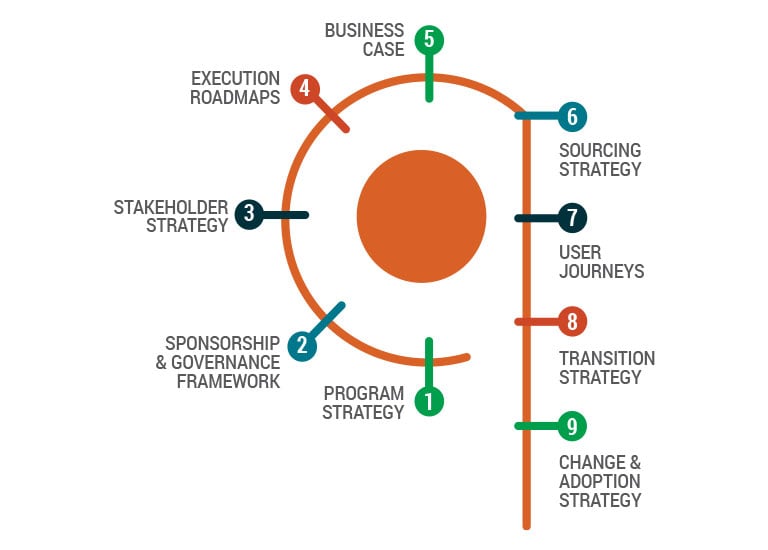Strategic Business Analysis
Create strategies for change and design initiatives that are sustainable throughout the organization to enable successful business led transformation.
What is Strategic Business Analysis?
Change is necessary for organizations to continue to thrive and grow, but how do you pivot strategy and retool an organization to remain relevant?
Strategic business analysis involves outcome focused thinking, simultaneously understanding business context, business challenges, and the complexities of the internal and external environment to frame the scope of the transformation, articulate the business need/outcome, and shape the agenda for transformation. Strategic business analysis requires a focus on all aspects of the organization. It leverages business analysis, change leadership, and program and project management. Strategic business analysis focuses on ‘what and why’, not the ‘how’ of solution implementation.
Strategy to Execution Framework®
A companion to A Guide to the Business Analysis Body of Knowledge® (BABOK® Guide) the Strategy to Execution Framework will help those engaged with strategic business analysis to work more effectively with the business to create the strategies and elements that guide the business in moving from strategy to execution. It is a roadmap for successful business transformation that bridges the gap between strategy and execution enabling senior business leaders to drive successful implementation, minimize business risk, and increase adoption while using strategic business analysis to achieve desired outcomes.
9-Step Roadmap for Successful Business Transformation
The Strategy to Execution Framework® is a proven roadmap that provides the foundations and transparent pathways for business change.
The strategies and elements in the Strategy to Execution Framework are presented in a logical and natural order, but in practice, they may be applied in different sequential order and in parallel depending on the context and needs of individual organizations.
The strategy to execution process can be used in conjunction with other frameworks as needed. Most often it tends to precede other frameworks and methodologies because it forms the bridge between strategic planning and implementation and sets the foundations for a business-led change program or transformation program.
The focus of the strategy to execution process is on programs rather than projects, as programs produce a business outcome that is aligned to the strategy.
A CORPORATE LICENSE IS REQUIRED TO USE THE STRATEGY TO EXECUTION FRAMEWORK IN A CORPORATE SETTING
LEARN ABOUT LICENCING FOR CORPORATE USE

-
1
Program Strategy
The program strategy provides the foundations for a transformation or change. It helps to determine how to solve business problems in a way that will ensure the best result.
-
2
Sponsorship and Governance Framework
The sponsorship and governance framework creates a terms of reference document that outlines the program organisation structure, roles, and responsibilities of each of the functional areas.
-
3
Stakeholder Strategy
The purpose of the stakeholder strategy is to form partnerships with the stakeholders, with the “term partnership” referred to as establishing working and committed relationships.
-
4
Execution Roadmaps
Execution roadmaps have value because they provide a high-level view of all the moving parts of programs in context. They also provide focus on the outcome and what is needed when and by whom.
-
5
Business Case
A business case captures the reasoning and justification for initiating the program or project and the anticipated commercial benefits. It enables the executive to make an investment decision.
-
6
Sourcing Strategy
A sourcing strategy guides procurement. It ensures alignment with the information, communication, and technology (ITC) strategy.
-
7
User Journeys
User journeys are the visualization of the strategy. Their construction leverages design thinking and are part of sensemaking for stakeholders.
-
8
Transition Strategy
A transition strategy focuses on the long-term strategy of the transformation and the future releases and generations. It helps inform the sourcing strategy and procurement of services for ongoing support and maintenance of products and services.
-
9
Change and Adoption Strategy
A change and adoption strategy focuses on adoption and the strategies for change. It is key to delineating the strategic change and activities required for the transformation and the organisation change and activities required.
Drives Successful Implementation, Minimize Business Risk And Increase Adoption While Achieving Desired Outcomes
Corporate usage is available through IIBA’s Global Corporate Program or a Corporate License purchased from IIBA. A Corporate License or Membership allows usage of the framework by organizations that employs business analysis professionals. The Corporate License allows organizations and teams:
- Enterprise access to the framework
- Customize The Strategy to Execution Framework for internal corporate usage